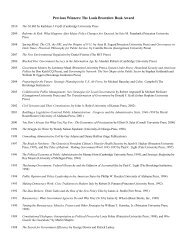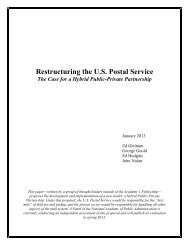High-Performance Partnerships - National Academy of Public ...
High-Performance Partnerships - National Academy of Public ...
High-Performance Partnerships - National Academy of Public ...
You also want an ePaper? Increase the reach of your titles
YUMPU automatically turns print PDFs into web optimized ePapers that Google loves.
MANAGEMENT APPROACHES<br />
AND ATTRIBUTES<br />
chapter twelve<br />
I<br />
n traditional hierarchal organizations, an effective manager is technically competent<br />
and well equipped to deal with vertical decision-making. The manager<br />
achieves results by working with employees and volunteers, reporting to a single boss,<br />
and having a defined set <strong>of</strong> responsibilities, powers, and authorities.<br />
The design lab participants identified different<br />
skills for high-performance partnership managers,<br />
who must focus on achieving results, not<br />
overseeing work processes. The ends—not the<br />
means—are top priority. Also, the manager<br />
must be adept at embracing, organizing, and<br />
facilitating a collaboration <strong>of</strong> members with<br />
different perspectives, needs, and ways <strong>of</strong><br />
doing business. Time and energy are needed<br />
to glue the partnership together and keep its<br />
members engaged, on track, and productive.<br />
Managers must be able to embrace a vision<br />
that stretches beyond a single organization and<br />
convince others to do the same. A high-performance<br />
partnership ultimately is accountable<br />
for its outcomes. A manager overly focused on<br />
“Just speaking the language <strong>of</strong> partnering does not<br />
mean you know how to do it.”<br />
Tony Macklin, Family Strengthening Coalition (Indianapolis)<br />
process can lose sight <strong>of</strong> the desired outcome.<br />
Table 12-1 highlights some <strong>of</strong> the most important<br />
differences between a high-performance<br />
partnership and a traditional organization.<br />
A partnership integrates organizations that<br />
have potentially overlapping or competing<br />
agendas. The management approach must be<br />
to build consensus using negotiation and facilitation.<br />
A manager cannot dictate a decision<br />
but must share power. Given the participants’<br />
broad range <strong>of</strong> perspectives and cultures, managers<br />
must recognize the value <strong>of</strong> differences<br />
and weave them into a coherent organizational<br />
fabric. If results miss their target, the manager<br />
must assess the situation quickly, change tactics,<br />
and move the partnership forward.<br />
Hierarchical rigidity is not nimble or sufficiently<br />
responsive in the high-performance<br />
arena. Flexibility is essential.<br />
Communicating up, down, and across is critical.<br />
Identifying the right message also is key. The<br />
communications challenges discussed earlier<br />
TABLE 12-1<br />
MANAGEMENT APPROACHES<br />
HIGH PERFORMANCE VS.TRADITIONAL<br />
Management<br />
<strong>High</strong>-<strong>Performance</strong><br />
Traditional<br />
Characteristic<br />
Partnership<br />
Organization<br />
View Visionary Task<br />
Driver Results Process<br />
Decision-making Shared Directive<br />
Structure Team Hierarchical<br />
Communications 360˚ Top down<br />
Style Coach Directive<br />
Focus Customer Organization<br />
Boss Multiple Single<br />
130 Powering the Future: <strong>High</strong>-<strong>Performance</strong> <strong>Partnerships</strong>









